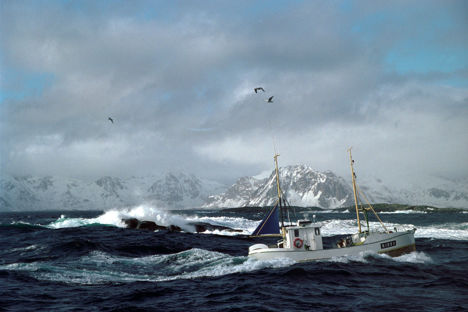
Norwegian cod fishing: a day in the life
Sindre Johan Dyp is skipper on board a fishing boat that brings in cod from all around Norway. Find out why he loves his job, what it's like to spend weeks at sea and why Norwegian fish are the best in the world.
Norwegian cod fishing: a day in the life
Sindre Johan Dyp is skipper on board a fishing boat that brings in cod from all around Norway. Find out why he loves his job, what it's like to spend weeks at sea and why Norwegian fish are the best in the world.
Fishing, like dairy farming, is more than a job – it’s a lifestyle. Days away at sea, not seeing land for weeks and working in constant shifts to catch as many fish as possible during your time out in the ocean means it’s certainly not for everyone. As one of the world’s great fish exporting nations, amongst the highest Marine Stewardship Council (MSC)-certified fisheries in the world (100% of Norway's North East Atlantic cod and haddock is certified), Norway's economy is dependent on seafood and its fisheries management system is strictly regulated – after all, the country's heritage is at sea and it needs to provide livelihoods long into the future. Because of this, Norway certainly has its fair share of fishermen, who are often required to spend six weeks on the water at a time.
Sindre Johan Dyp is one of these fishermen – as a skipper, he is responsible for a crew of around thirty-two, and spends most of his life at sea. Here, he describes an average day on board the boat and why Norwegian cod is so special.
‘I wake up, have half an hour for breakfast, grab a coffee and put my overalls on. I then go straight out onto the deck, swapping shifts with two or three crew members who have been working for eight hours. For the first hour we’re just pulling in the line, catching as many fish as we can, and then spend the next hour reattaching the hooks. We repeat this process one more time, and then it’s time for a half hour break and something to eat.
The final four hours are spent ‘shooting the line’, which just means putting bait on the hooks we prepared earlier and casting them out to sea. As soon as all of them are out, we begin pulling them in again. About seven men are doing this at any time of day or night, in two shifts.
There are around thirty-two men working together, both ashore and on the boat, in one big crew to help get the fish ready to sell. I’m the skipper, there’s one mate, an engineer, two in the wheelhouse and then the guys bringing in the fish on deck. We’re at sea for four, five or even six weeks at a time, working in two halves so there is always a team ready to come aboard when we have finished our run. This happens throughout the whole year – we only take time off between Christmas and New Year and take another week to do repairs to the boat.
When you’re on the boat you get eight hours off a day, which is when most of us relax, sleep, read or watch films. There’s an area with exercise bikes if people want to work out, and we play a lot of cards. It’s really important to have fun while you work as well, though, as it keeps spirits up during the tougher times at sea. Most of the crew grew up together in the same town, so they’re old friends.
The fish we catch really is the best quality in the world. It’s still alive when it comes out of the water, and within a few hours it is in deep freeze on-board the boat. When we get back to shore there are a team of four or five men who wash, fillet and package it up ready for sale as quickly as possible.
I find fishing such an individual and unique way of life, and it’s such interesting work. You always have a lot to do in a short amount of time, which is why we have to find a good balance between working hard and having fun. It’s also dangerous at times, so safety is key. I don’t like it when the weather’s bad, as it completely tires you out and adds pressure to everything, especially when you’re a skipper and responsible for your crew. But fishing off the coast of such a beautiful country is great.’


